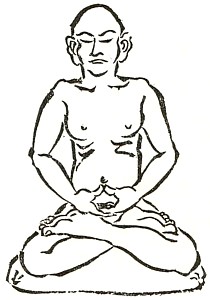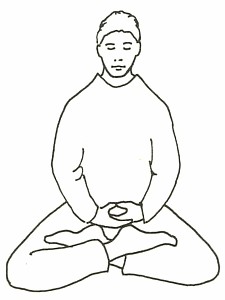Crossing the legs (Adult practice 35)
 Original edition of Sawaki's "Zendan" |
 1st edition of Uchiyama's "Opening the hand of thought" |
 New edition of Uchiyama's "Opening the hand of thought" |
|---|
Exactly one year has passed since I wrote about how to sit in zazen for the last time in this "adult practice" corner. Although we have now finally come to the actual posture of sitting, I stopped writing about the topic for a long while. The reason is simply that I was busy with a lot of things, but that is not to say that I had more important things to do than to write about such trivial matters as how to sit cross-legged in zazen. No, it is the other way around. I think that the matter is too important to be handled with in a light and superficial way, so I wanted to take my time to write about it.
Unfortunately, I can not say that now I have finally found the leisure to write and explain everything as detailed as I wish I could. Also, as you can imagine, it is almost impossible to write about the act of sitting without some kind of live demonstration in the first place. Anyway, I feel that I do not continue with "adult practice" now, I will probably never do. So I will just go on where I stopped last spring.
Last april I wrote about the first part of the section called "starting with zazen", in which Sawaki Roshi talked about bowing in gassho. The section continues like this (translated from the Japanese original):
The physical posture
Place your buttocks on the cushion (zafu). Line up both legs in front of you, and - while holding the lower ends of your robes in a way that is in accord with the etiquette - cross the legs inside your garment, covering them with the ends of both kimono and koromo. Do not sit too deep on the cushion. You should have the feeling of placing only the spine on it. Thus, half of the cushion should protrude from behind your buttocks. The crossed legs should rest on the square sitting mat (zaniku).
What is important here is that the round cushion called zafu is only used to support the buttocks, thus faciliating the bending forward of the pelvis. The zafu is not used to support the legs. The kness are resting on the square mat called zaniku (or in places like Eiheiji or Zuioji, where no zaniku is used, directly on the tatami). Thus the trunk is supported by the triangle that is formed by both knees and the bottom of the spine. In Rinzai Zen, where no zafu is used, the long rectangular sitting mat that also serves as a futon and zaniku is folded at the end to support the bottocks. Many training monks seem to be ignorant of this fact though and sit without bending their pelvis forward, as the lack the support under their spine (the same is true of many Southern Buddhist traditions).
When crossing your legs, it is considered a violation of the etiquette when you open your kimono and koromo in a way that others can see your naked legs or under wear. Although it makes the act of crossing the legs a little more complicated, Japanese monks and nuns usually make a point of crossing there legs inside the garment, i.e. covering them up before they cross them, not the other way around. Kimono and koromo are wrapped around the legs, the kesa usually just sits on top of the legs (so it is not tugged under).
The translation of the following section is from the English book "shikantaza":
Crossing your legs
Kekkafuza (Full-lotus position)
Place your right foot on your left thigh, and then your left foot on your right thigh. Cross your legs firmly so that the tips of your toes and the outer edge of your thighs form one single line.
Hankafuza (Half-lotus position)
Simply place your left foot on your right thigh. When you cross your legs, your knees and the base of your spine should form an equilateral triangle. These three points support the weight of your body.
In kekkafuza, the order of crossing the legs can be reversed, and in hankafuza, raising the opposite leg is acceptable.
In the original Japanese text of "Zendan", it is even said that it is alright to switch the order of the legs in the midst of zazen if they start to hurt, or to switch from kekkafuza to hankafuza or the other way around. Those kind remarks are quite a change of tone compared to the militaristic instruction that we encountered in the issue of "adult practice" of February 2005:
"Push your lower back forward and the behind so far back that your anus points straight backwards."
"Draw back the chin until the skin behind your ears starts to hurt."
"Your consciousness has to be in a state of tension."
At Antaiji, I usually do not recommend that people switch their legs during zazen, but rather I ask them to sit with the determination to die on the cushion (but few have actually done so until now).
Be that as it may, there are two points here I would like to invest further: First, is it enough to just aim at placing the feet as high as possible on the opposite thigh, even if the toes actually end up sitting somewhere in the center of the thigh, or are we supposed to really have the tips of the toes in line with the outer edge of the thighs? Or, in other words, does the triangle that is formed by the two knees and the base of the spine necessarily have to be equilateral, or is it alright if the baseline that is formed by the two knees is somewhat longer than the other two lines?
Second, both in Fukanzazengi and Zazengi we find Dogen Zenji only mentioning sitting with the right foot on the left thigh and the left foot on the right thigh (=kekkafuza) or with the left foot on the right thigh only (=hankafuza). Nowhere does he talk about the reverse way of crossing the legs. That means that the left leg is in any case raised higher than the right leg. My question is: Does Dogen Zenji have a reason for mentioning only this way of sitting, and not the reverse one? And is the reason merely a historical or cultural one, or does it root in the human anatomy and the functioning of zazen in the body? Depending on what the reason for Dogen's preference of the "left side up" is, we might further ask if it is really alright to have either foot up, regardless if it is the right or left foot. And we might further ask how it is with the hands. Can we switch the hands too?
These questions might seem trivial to some. But if you spent 1800 hours a year in zazen, in either hankafuza or kekkafuza, the exact way of crossing the legs is nothing less than trivial. It becomes a vital point of practice. Therefore I would like to continue to invest these points further next time.